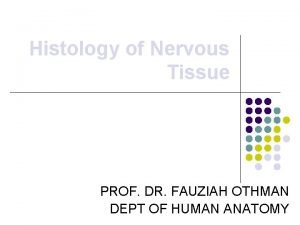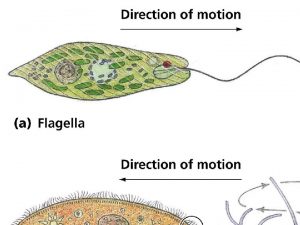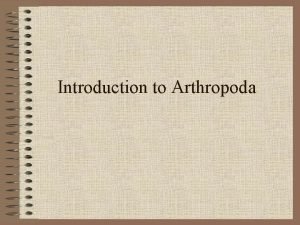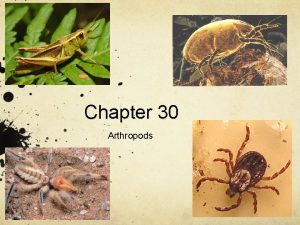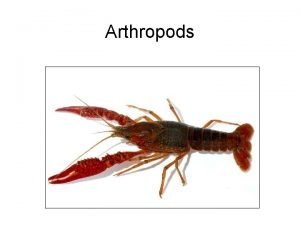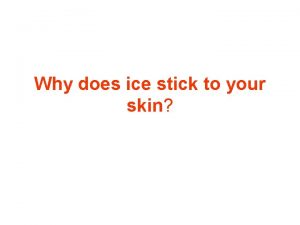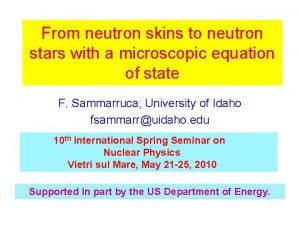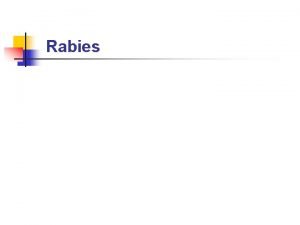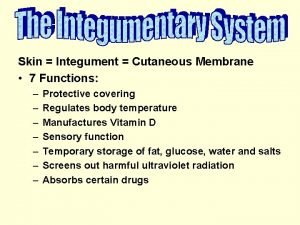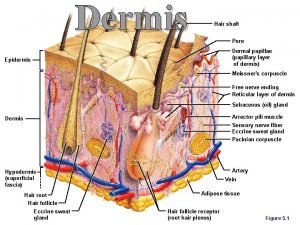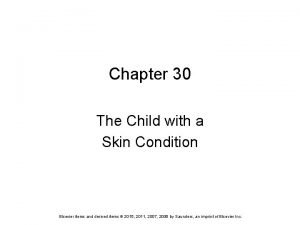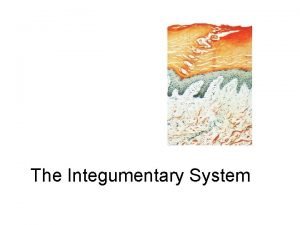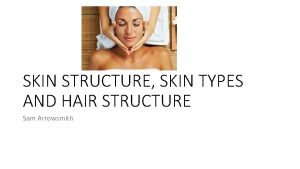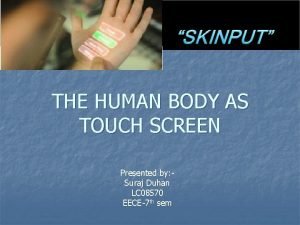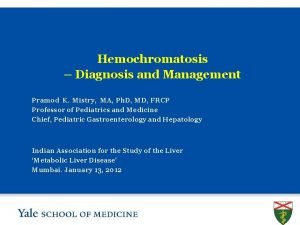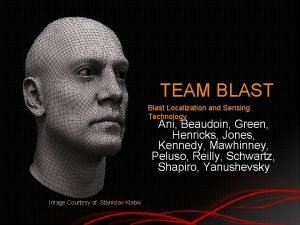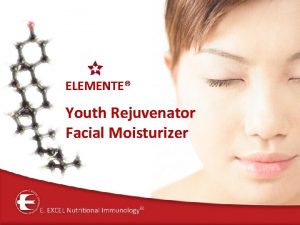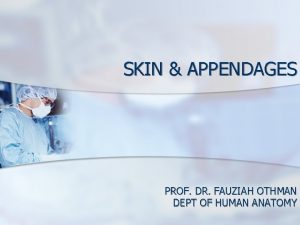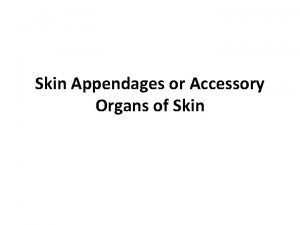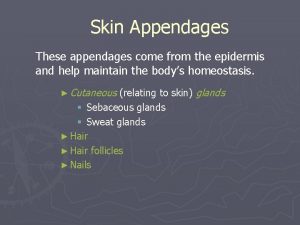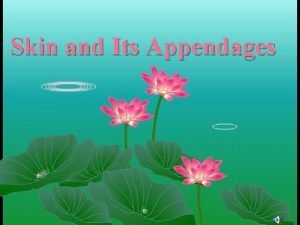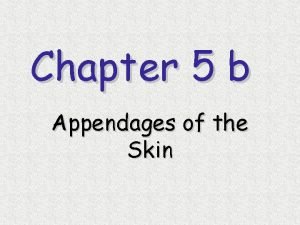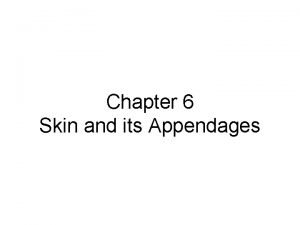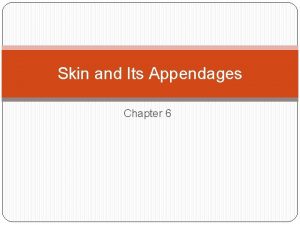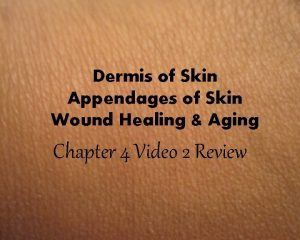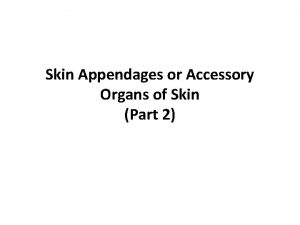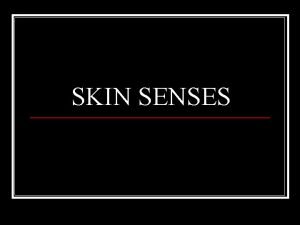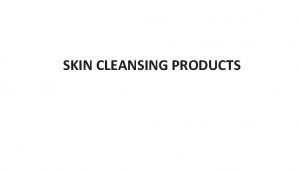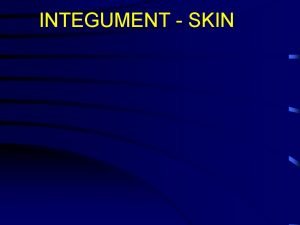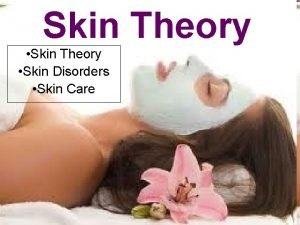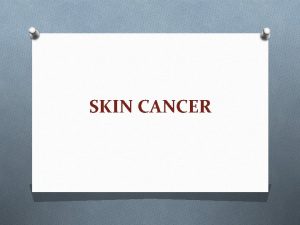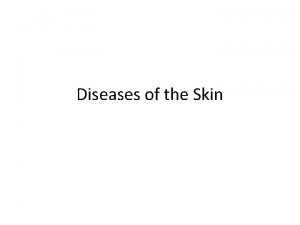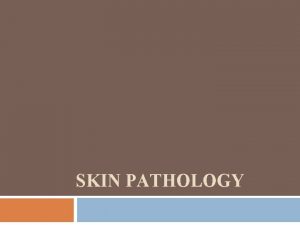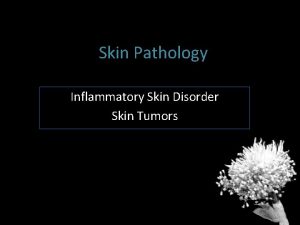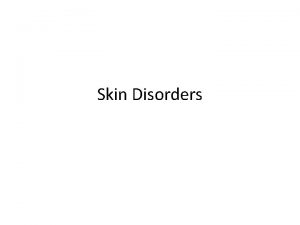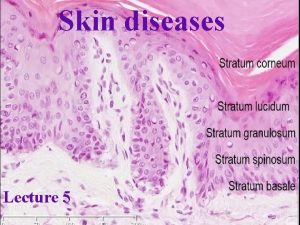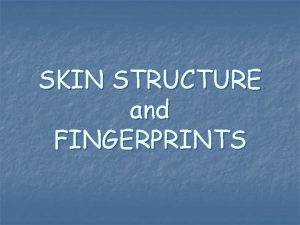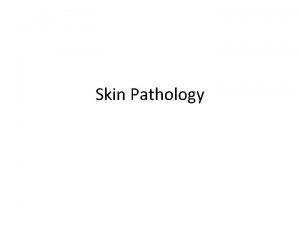C ET 1 SKIN APPENDAGES PROF DR FAUZIAH































- Slides: 31

C & ET 1 SKIN & APPENDAGES PROF. DR. FAUZIAH OTHMAN DEPT OF HUMAN ANATOMY

Contents: n n n n Function of skin Epidermis- layer & cell of epidermis Dermis –papillary layer & reticular layer Subcutaneous tissue Blood vessels & skin sensorial receptors Hairs Nails Glands of skin: sweat gland & sebaceous gland.

Skin layers: epidermis, and subcutis, showing a hair follicle, sweat gland & sebaceous gland.

Function of Skin Protection n Sensation n Heat regulation n Control of evaporation n Aesthetics and communication n Storage and synthesis n Excretion n Absorption n Water resistance n

Epidermis- layer & cell of epidermis Outermost layer of the skin n About 90% of the epidermal cells are keratinocytes n Made up of stratified squamous epithelium with an underlying basal lamina. n

5 layers 1. 2. 3. 4. 5. stratum basale stratum spinosum stratum granulosum stratum lucidum stratum corneum Bottom Top


Cell of epidermis n Three types of specialized cells Melanocyte= produces pigment (melanin) n Langerhans' cell = frontline defense of the immune system in the skin n Merkel's cell's = is not clearly known n


Dermis –papillary layer & reticular layer Layer of skin beneath the epidermis. n Consists -connective tissue - cushions the body from stress and strain. n Tightly connected to the epidermis basement membrane, and harbors many nerve endings that provide the sense of touch and heat. n

n It contains the hair follicles, sweat glands, sebaceous glands, apocrine glands, and blood vessels. The blood vessels in the dermis provide nourishment and waste removal to its own cells, as well as the Stratum basale of the epidermis.

n The dermis superficial area adjacent= papillary region Deep thicker area= Reticular region

Papillary Layer n Thin arrangement of collagen fibers -fingerlike projections -composed of loose areolar connective tissue n Fx= supplies nutrients =regulates temperature (Constriction and expansion control the amount of blood that flows through the skin and dictate whether body heat is dispelled when the skin is hot or conserved when it is cold. )

Reticular Layer Thicker and made of thick collagen fibers that are arranged in parallel to the surface of the skin. n Denser than the papillary dermis, and it strengthens the skin, providing structure and elasticity. n It also supports other components of the skin, such as hair follicles, sweat glands, and sebaceous glands. n

Subcutaneous Tissue Layer of tissue directly underlying the cutis. n composed of adipose tissue & connective tissue that houses larger blood vessels and nerves. n The thickness depends on the amount of fat present. Its physiological function includes insulation and storage of nutrients n

Blood vessels & skin sensorial receptors

n Heat, cold, touch, texture, pressure, vibration, and tissue injury (pain) n abundant on the face, palms, fingers, soles, nipples and genitals. n relatively few and joint areas on the back,

sensory receptors in skin Name Hair Follicle Ending Ruffini Endings Krause corpuscle Pacinian corpuscle Location Hairy Skin Areas Dermis of hairy and glabrous skin Function responds to hair displacement Lips, tongue, genitals Deep layers of demis in hairy and glabrous skin responds to pressure responds to vibration sensitive at 150 -300 Hz range responds to pressure on skin

responds to vibration sensitive at 20 -40 Hz range Meissner corpuscle Demis of glabrous skin Free nerve endings different types of free nerve endings respond to Throughout your mechanical, skin thermal, or noxious stimulation Merkel Epidermis of glabrous skin responds to pressure of the skin

Hairs n n Itself is dead, but it's produced by living cells. largely made up of a protein called keratin. Cells in the hair follicle regularly produce the keratin and other proteins that become incorporated into the hair shaft. Coloration comes from melanocytes which produce the brown pigment melanin



Nails n made of a tough protein called keratin and have many different parts

n Nail body- visible portion of the nail n Nail bed –cover an area epidermis The free edge of the nail-distal portion that continues past the nail bed n Hyponychium – an area of thickened stratum corneum. n

n Nail root - nail production occurs n Eponychium/ cuticle - aportion of stratum corneum of the nail root extend over the exposed. n Lunula- near the root, vessels may be obscured, leaving pale cresent.

Glands of skin: sweat gland & sebaceous gland


n Skin contains 2 types of exocrine glands 1. Sebaceous glands ( produce oily lipid that coat hair shafts & the epidermis) 2. Sweat glands ( produce watery solution & perform other special functions. )

Sebaceous glands n Holocrine glands that discharge a waxy, oily secretion into hair follicles n Communicate with the single follicle share a duct & thus classified as simple branched alveolar glands

n Gland cell = produce large quantities of lipid- mature Secretion of lipids= sebum ( triacylglycerides+ cholesterol+ proteins + electrolyte) n

Sweat gland n 1. 2. Other name=Sudoriferous glands Apocrine gland Merocrine gland * Names refer to the mechanism of the secretion
 Fauziah othman
Fauziah othman Fauziah zen
Fauziah zen Puji yanti fauziah
Puji yanti fauziah Milady basic facial steps
Milady basic facial steps Skin information
Skin information Thin skin vs thick skin
Thin skin vs thick skin Whip like appendages
Whip like appendages Arthropoda symmetry
Arthropoda symmetry Have segmented bodies
Have segmented bodies Arthropods segmentation
Arthropods segmentation Whorled antennae
Whorled antennae Arthropod
Arthropod Windows media player skins
Windows media player skins Why does ice stick to skin
Why does ice stick to skin Neutron skin
Neutron skin Rabies vaccine dose
Rabies vaccine dose 7 functions of skin
7 functions of skin Papillae of skin
Papillae of skin Chapter 30 the child with a skin condition
Chapter 30 the child with a skin condition John zic
John zic Are impressions left by friction ridge skin on a surface
Are impressions left by friction ridge skin on a surface Skin pigmentation
Skin pigmentation What protects cushions and insulates the skin
What protects cushions and insulates the skin Frog skin
Frog skin Hair structure types
Hair structure types Human being skin as touch screen
Human being skin as touch screen Nu skin compensation plan
Nu skin compensation plan Pramod mistry
Pramod mistry The skin that we speak
The skin that we speak Five layer of skin
Five layer of skin Teamblast skin
Teamblast skin Youth rejuvenator
Youth rejuvenator
